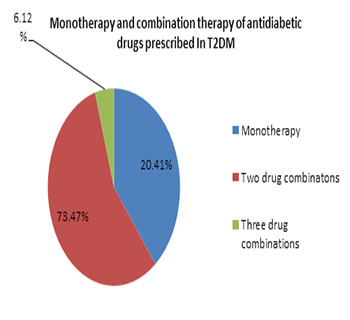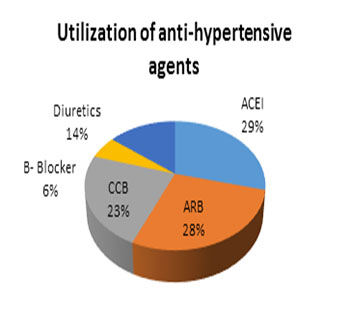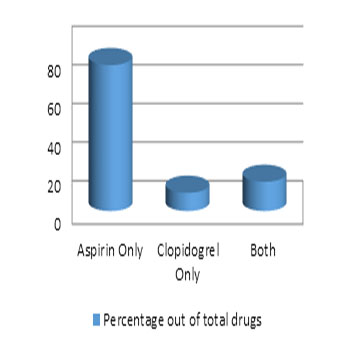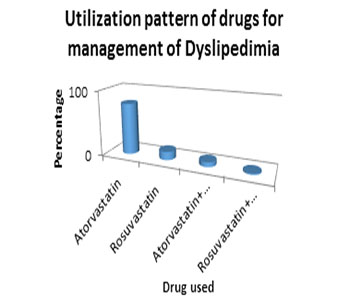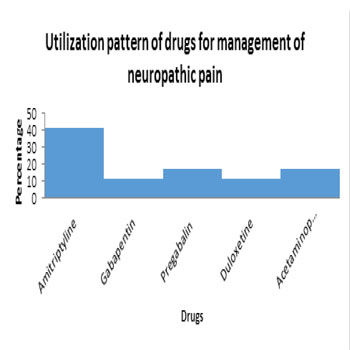Previous Issues Volume 2, Issue 1 - 2017
Prevalance of Chronic Complications and Drug Utilization Pattern of Type II Diabetes Mellitus
Santusta Adhikari1, Sunil Shrestha1*, Rajani Shakya2, Niranjan Koirala3
1Pharm.D, Department of Pharmacy, Kathmandu University, Dhulikhel, Nepal.
2Head of Department, Department of Pharmacy, Kathmandu University, Dhulikhel, Nepal.
3Head of Department, Department of Medical Biochemistry, Pokhara University, Sinamangal, Nepal.
Corresponding Author: Sunil Shrestha, Pharm.D, Department of Pharmacy, Kathmandu University, Dhulikhel, Nepal, E-Mail: [email protected]
Received Date: 27 Feb 2017 Accepted Date: 08 Mar 2017 Published Date: 13 Mar 2017
Copyright © 2017 Shrestha S
Citation: Adhikari S, Shrestha S, Shakya R and Koirala N. (2017). Prevalance of Chronic Complications and Drug Utilization Pattern of Type II Diabetes Mellitus. Mathews J Diabetes Obes 1(1): 006.
ABSTRACT
Background: Diabetes is an emerging global health problem in Nepal. Currently there is dearth of nation-wide data regarding the prevalence of chronic complications and drug utilization pattern. This study will help health-care professionals approach management more aggressively to prevent complications. Objectives: To assess the prevalence of chronic complications of type 2 diabetes and analyze drug utilization pattern at tertiary care health centers of Nepal. Methods: This is a descriptive, prescription based, and retrospective study. A sample size of 98 was selected systematically. Data were collected from patient case records and Prescriptions. The obtained data were entered in the structured patient profile form, and the filled forms were analyzed. Results: Out of the total 98 cases evaluated, 52 (53.06%) were males and 46(46.93%) were females. The mean age was 54.24±12.48. At least one chronic complication was found in 71(72.44%) of the study subjects. The prevalence of the associated diabetic complications were as follows viz. Hypertension (51.02%), IHD (23.46%), retinopathy (28.57%), nephropathy (24.48%) Neuropathy (15.30%), dyslipidemia (45.91%), diabetic foot (5.10%) and cerebrovascular conditions (1.02%). The overall utilization pattern of drugs were as follows viz. anti-diabetics ( 39.30%), anti-hypertensive ( 12.59%), antiplatelets( 9.6%), lipid lowering agents ( 10.2%), vitamins and minerals ( 10.58%),GI drugs( 7.29%), antimicrobials( 5.29%), others (5.10%). Among anti-diabetic drugs, metformin (39.30%) was the most preferred agent both as monotherapy and combination therapy. Likewise, preferred drugs for management of hypertension, IHD, dyslipidemia and neuropathy were ACEI (28.98%), Aspirin (75.47%), Atorvastatin (78.57%), and Amitriptyline (41.1%) respectively. Conclusion:The prevalence of chronic complication among type 2 diabetic patients was found to be high. Although poly pharmacy was observed, drug utilization pattern can be rational owing to higher prevalence of complications. Early diagnosis, intensive blood glucose control and rational drug selections should be encouraged to minimize the occurrence of complications.
KEYWORDS
Chronic Complication; Diabetes; Nepal; Drug Utilization.
INTRODUCTION
Diabetes is defined as “A metabolic disorder of multiple etiology characterized by chronic hyperglycemia with disturbances of carbohydrate, fat and protein metabolism resulting from defects in the insulin secretion, insulin action, or both” (WHO). High blood Sugar is the hallmark of diabetes that increases the risk of complications. Failure to control elevated blood sugar or inadequate treatment of diabetes could cause number of complications. Generally, the injurious effects of diabetes are separated into macro vascular complications (coronary artery disease, peripheral arterial disease, and stroke) and micro vascular complications (diabetic nephropathy, neuropathy, and retinopathy) [1]. A report on diabetes and its risk factors indicated that risk of myocardial infarction increased by 3-6 times. Similarly, it increases the risk of heart failure by 2-3 times, risk of amputation 45 times, blindness 10-25 times and Kidney failure 15-20 times [2]. Diabetes long considered a disease of minor significance to world health, is now taking its place as one of the main threats to human health in the 21st century. The global figure of people with diabetes is set to rise from the current estimate of 150 million to 220 million in 2010 and 300 million in 2025 [3]. According to International Diabetes Federation, Four out of every five people with diabetes now live in developing countries, with most affected men and women of working age. Diabetes is an endemic disease in Nepal, and is bringing new challenges in connection with rapid urbanization and modernization. The Nepal Diabetes Association reported that diabetes affects approximately 15% of people = 20 years and 19% of people = 40 years of age in urban areas. According to WHO, diabetes affects more than 436,000 people in Nepal, and this number will rise to 1,328,000 by 2030. The study conducted by Chhetri [4] showed diabetes prevalence was 25.9% and higher proportion of diabetes was demonstrated in male (27.1%) than the females (24.8%) in Kathmandu valley of Nepal. Increased body weight due to high intake of fatty and other food and low physical activity are the main reasons for the diabetes epidemic in urban Nepal. The problem of diabetes is reflected by its increasing complications. Diabetes is reported to be leading cause of chronic renal failure in Nepal [5].
MATERIALS AND METHODS
Study type
This was the multicentre, retrospective cross sectional study. All the patients who meet inclusion criteria were taken as study population.
Study site
This study was carried out in Dulikhel Hosptial, Nepal Thyroid and Endocrine Centre Hospital (Metro Clinic), Alka Hospital, Norvic International Hospital and Research Centre, and Tribhuvan University Teaching hospital.
Study Population and Inclusion and Exclusion Criteria
The study population of this study was all diabetic patients having complete medical record. The patients who met the inclusion criteria were enrolled in the study. The inclusion and exclusion criteria were as follows.
Inclusion criteria
1. Patient diagnosed of Type II Diabetes Mellitus.
Exclusion criteria:
- Patients with Type 1 Diabetes.
- Mentally retarded and psychiatric patients
- Patients below 12 and above 85 years of age
- Pregnancy induced diabetes
Sample Size
The study population is of 98 patients.
Data Collection
Data collection form was developed to collect the data. There were two parts in data collection form; Pharmacist's patient profile form and Medication study form.
Data Entry and Analysis
Data was entered in Microsoft office Excel worksheet and was analyzed.
Approval for the study
The proposal for a project work was approved from the department of Pharmacy, KU. After that approval was taken from the hospitals where data collection was done.
Feasibility of the study (Pilot Study)
Pilot study was carried out for one week. Necessary changes in the data collection forms and methods were done accordingly. Data collected during pilot study are not included in data analysis.
RESULTS
Based on the study criteria, 98 cases were selected and taken for the study. Of the total patient majority were male (53.06%, N: 52) in comparison to female (46.93%, N: 46) and 40 (40.8%) were belonged to the age group 51-60 years and 30 (30.6%) were in the age group 41-50. According to the body mass index (BMI), 20 (20.4%) of the patient has normal weight followed by 29 (29.59%) were overweight and 49 (50%) patient were obese. (Table 1)
Table 1: Demographic Characteristics of Diabetic Patients (n=98).
| Variable | Total patient n (%) |
| Gender | |
| Male | 52 (53.06) |
| Female | 46 (46.93) |
| Age (years) | |
| 21-30 | 1 (1) |
| 31-40 | 5 (5.1) |
| 41-50 | 30 (30.6) |
| 51-60 | 40 (40.8) |
| >60 | 22 (22.4) |
| BMI (kg/m2) | |
| Normal | 20 (20.4) |
| Overweight | 20 (29.59) |
| Obese | 49 (50) |
BMI: Body Mass Index
Of the 98 patient 37 (37.75%) shows familial association with type 2 diabetes and 34 (34.69%) were suffering from diabetes for 6-10 years followed by 25 (25.51%) and 18 (18.36%) had type 2 diabetes mellitus for 11-15 years and 16-20 years respectively. The mean glycosylated haemoglobin (HbA 1 C) level observed in the study population was 7.2. Patient were suffering from different types of complication. 26 (26.53%) patient do not shows any complication while majority shows single complication (N: 32, 32.65%) followed by two complication (N: 24, 24.48%) and three and more complication (N: 15, 15.30%) (Table 2).
Table 2: Clinical characteristics of Diabetic Patients (n=98).
| Variable | Total patient n (%) |
| Family history of diabetes | 37 (37.75) |
| Duration of diabetes (years) | |
| 0-5 | 11 (11.22) |
| 6-10 | 34 (34.69) |
| 11-15 | 25 (25.51) |
| 16-20 | 18 (18.36) |
| >20 | 10 (10.2) |
| HbA1c level | % |
| Mean | 7.2 |
| Minimum-Maximum | 6.2-11.5 |
| Prevalence of complication | |
| No complication | 26 (26.53) |
| Single complication | 32 (32.65) |
| Two complication | 24 (24.48) |
| Three and more complication | 15 (15.30) |
(Table 3) shows the category wise prevalence of complication among the study population. Cardiovascular complications were observed in majority of population with gross prevalence of 73.46% followed by dyslipidemia (N: 45, 45.91%), diabetic retinopathy (N: 28, 28.57%) and diabetic nephropathy (N: 24, 24.48%). Hypertension is most prevalent among cardiovascular complication.
Table 3: Category Wise Prevalence of Complications.
| Complications | Frequency (%) |
| Cardiovascular | |
| Hypertension | 72(73.46) |
| IHD | 50(51.02) |
| Chronic heart failure | 23(23.46) |
| Diabetic nephropathy | |
| Renal failure/Microalbiminuria | 24(24.48) |
| Diabetic retinopathy | 28(28.57) |
| Cerebrovascular(stroke) | 1(1.02) |
| Diabetic foot | 5(5.10) |
| Diabetic neuropathy | 15(15.30) |
| Dyslipidemia | 45(45.91) |
During the study period, a total of 215 OHAs were prescribed to the patient. Biguanides (N: 85, 86.7%) were the most commonly prescribed class, followed by sulphonylureas (N: 67, 68.3%), Alpha-glucosidiase inhibitors (N: 22, 22.45), sitagliptin (N: 10, 10.2%) and thiazolidinedione (N: 9, 9.2%). (Table 4) shows that 22 of the studied patient received insulin alone or in combination with oral antidiabetic drugs (15.30%) (Table 5). A significant number of patients were prescribed combinational therapy (N: 78, 79.59%) as compared to monotherapy (N: 20, 20.41%). The patients were treated with one (N: 20, 20.41%), two (N: 72, 73.47%) and three (N: 6, 6.12%) Oral Hypoglycemic Agents (OHAs). Among the various antidiabetics, sulphonylureas and Biguanides combination drug was the common class of drug accounting for 48 (48.97%) of the total antidiabetics. Details of the class of antidiabetic drugs and combination prescription pattern for enrolled patients are presented in Table 4 and 5 respectively.
Table 4: Type of Hypoglycemic Agents Prescribed (n=98).
| Class | Frequency (%) |
| Insulin | 22(22.4) |
| Biguanides | 85(86.7) |
| Sulphonylureas | 67(68.3) |
| Sitagliptin | 10(10.2) |
| Thiazolidinedione | 9(9.2) |
| Alpha- Glucosidiase Inhibitors | 22(22.4) |
Table 5: Pattern of Anti-Diabetic Combinations used in Study Population (n=98).
| Combination (s) | Frequency (%) |
| Glimepiride + Metformin | 41(41.83) |
| Glibenclamide + Metformin | 7(7.14) |
| Metformin + Acarbose | 7(7.14) |
| Glimepiride + Metformin + Pioglitazone | 6(6.12) |
| Sitagliptin + Metformin | 2(2.04) |
| Metformin + Insulin | 15(15.30) |
Figure 1:Mono-therapy and combination therapy of anti-diabetic drugs prescribed in type 2 diabetic patients.
MANAGEMENT OF COMPLICATIONS Table 6: Management of Complications
| Class | Number of prescriptions | Percentage of total number | ||
| A. Cardiovascular complications | Hypertension | ACEI | 20 | 28.98 |
| ARB | 19 | 27.53 | ||
| CCB | 16 | 23.18 | ||
| B- Blocker | 4 | 5.79 | ||
| Diuretics | 10 | 14.49 | ||
| Total | 69 | |||
| IHD or prophylaxis for CV events | Aspirin Only | 40 | 75.47 | |
| Clopidrogel Only | 5 | 9.43 | ||
| Both | 8 | 15.09 | ||
| Total | 53 | |||
| Dyslipidemia | Atorvastatin | 44 | 78.57 | |
| Rosuvastatin | 7 | 12.5 | ||
| Atorvastatin+ Fenofibrate/ Ezetimbine | 4 | 7.14 | ||
| Rosuvastatin+ Fenofibrate | 1 | 1.78 | ||
| Total | 56 | |||
| B. Peripheral Neuropathy | Amitriptyline | 7 | 41.1 | |
| Gabapentin | 2 | 11.76 | ||
| Pregabalin | 3 | 17.6 | ||
| Duloxetine | 2 | 11.76 | ||
| Acetaminophen | 3 | 17.64 | ||
| Total | 17 |
NOTE: Angiotension-convertingenzyme inhibitor, ARB : Angiotensin Receptor Blocker, CCB: Calcium Channel Blocker
MANAGEMENT OF CARDIOVASCULAR COMPLICATIONS
Hypertension
Figure 2: Utilization of Anti-Hypertensive Agents.
Angiotensin converting Enzyme inhibitors (28.98%) were the most preferred agents in treatment of diabetic hypertensive followed by Angiotensin receptor blockers (27.53%), Calcium channel blockers (23%) and diuretics (14%). Angiotensin-converting enzyme inhibitor (ACE-I) / angiotensin receptor blocker (ARB) was the most commonly prescribed drug class both in mono and combination therapy.
Management of Ischemic Heart disease / CV events prophylaxis
Figure 3: Utilization of Anti-Platelet Agents
Out of total patients, 53 (54.08%) patients received one or more anti-platelet agents for ischemic heart disease or prevention of cardiovascular complications. From this study, it was discovered that aspirin was preferred agent (75.2% out of total anti-platelet agents) as mono-therapy used among Type II Diabetes Mellitues (T2DM) patients followed by a combination of aspirin and Clopidrogel.
Management of Dyslipidemia
Figure 4: Utilization of Hypolipidemic Agents.
The drug use evaluation studies of hypolipidemic agents showed that 91.87 % of the patients received statins. Fenofibrate and Ezetimibe were used rarely (9%) in combination with statins in patients with severe dyslipidemia which could not be managed by statin monotherapy. Among statins, atorvastatin (78%) was most commonly used cumulating both monotherapy and combination therapy, followed by rosuvastatin (14%).
Management of diabetic neuropathic pain
Figure 5: Utilization Pattern of Drugs for Management of Neuropathic Pain.
Diabetic neuropathic pain was managed by Amitriptyline (41.1) in majority of cases, followed by the anticonvulsants (Pregabalin (17.6%), gabapentin (11.76%), duloxetine (11.76%), Acetaminophen (11.76%).
Overall Utilization Patterns of Drugs
Table 7: Overall Utilization Pattern of Drugs
| Drug | Frequency (%) |
| Anti-diabetic | 215(39.30) |
| Anti-hypertensive | 69(12.59) |
| Anti-platelet | 53(9.67) |
| Lipid lowering agents | 56(10.2) |
| Analgesics (NP) | 17(3.10) |
| Antimicrobials | 29(5.29) |
| GI drugs | 40(7.29) |
| Vitamins and Minerals | 58(10.58) |
| Others | 11(2.00) |
| Total | 547 |
Anti-diabetic drugs accounted for almost 40% of the prescribed drugs followed by anti-hypertensive medications, which might be due to higher prevalence of hypertension (12.59%) among diabetic patients. The utilization of lipid lowering drug and anti-platelet drug was 10% and 9% respectively. Furthermore, the utilization patterns of drugs used in management of neuropathic pain was 3.10%.
DISCUSSION
A total of 98 diabetic patients were evaluated during the study period. In this study, male (53.06%) was found to predominant over female (46.93%), which shows outcome similar to study conducted, by Maskey et al., [5], Abdi et al., Ramesh et al., The mean age ± Standard deviation of total study patient was 54.24±12.48 years which goes in line with studies conducted by Syed Shahid Habib, [6] and Jayarama et al., Majority of patients n =40, (40.8%) were found to be in 51-60 years of age group and 30 (30.6%) patients were of the age group of 41-50 years indicating that the risk of T2DM increases after the age of 40 years. Roy V et al., [7] reported similar finding regarding age wise prevalence of diabetes. This study found out the prevalence of obesity and overweight among fifty percent and thirty percent of the study population, which shows concurrence to the studies conducted by C Daousi et al., [8] .Almost eighty percent of the study population was found to be either overweight or obese signifying higher prevalence of obesity or overweight among type 2 diabetic patients. Obesity is the major potentially modifiable risk factor for type 2 diabetes [9]. Out of 98 patients, 37 patients (37.75%) had a family history of diabetes which is comparable with the study of Patel et al., [10]. Family studies have revealed that first degree relatives of individuals with T2DM are about 3 times more likely to develop the disease than individuals without a positive family history of the disease. In our study, most of the patients had poor glycemic control as the mean HbA1c was found to be 7.20%. The findings of this study is in line with results given by Jayarama N et al., as mean HbA1 C reported to be 8.27. The highest Hb A1 C level observed in the study population was 11.5, and the lowest observed being 6.2. In this study, 71( 72.44%) out of 98 cases, were found to have one or more complications of diabetes which is quite similar to the study conducted by Abougalambou et al., [11] which reported 78% prevalence of complications. Moreover, the prevalence of complication is found to be quite higher than the studies conducted by Roaeid & Kadiki, [12]. Cardiovascular complications were observed in majority of population with gross prevalence of 73.46%, which is comparable to a study done National Health Service, Australia (2004–05 NHS). According to the report, more than 60% of people with diabetes had at least one form of CVD. Cardiovascular complications are listed as the cause of death in≈65% of persons with diabetes [13]. This present study estimated that about 51% of type 2 diabetic patients are suffering from hypertension, making it one major cardiovascular complications of diabetes. The findings of this study are supported by the studies conducted India, Taiwan, Sweden, Romania and Mexico [14]. According to world health organization, people with diabetes and hypertension have a two-fold increased risk of cardiovascular mortality compared to patients with diabetes alone (Clinical guidelines in management of hypertension, WHO 2005). Out of 98 Type 2 diabetic patients, almost 45% of patients were found to be suffering from dyslipidemia which is similar to the results of the study conducted by Samir et al, which reported that prevalence of dyslipidemia among diabetic patients to be about 50%. The result of this study is in contrast to a study conducted in western part of Nepal, which reported that prevalence of dyslipidemia in diabetic patients is 90.7%. Like-wise, the study conducted in Jordan reported that the prevalence of one or more forms of dyslipidemia in diabetic patients is more than 90% [15]. It has been observed globally that the prevalence of dyslipidemia varies according to the study population. This study found that, 24 out of 98 study populations had diabetic nephropathy, which is in line to the study conducted in India by Klein et al., [16]. This study reported that diabetic nephropathy is the most common cause of renal disease, accounting for about total 30 % of cases. This study found out the prevalence of diabetic retinopathy to 28.57 %, which is slightly less than global estimate of prevalence as reported to be 34.6% [17]. This study estimated the prevalence of diabetic neuropathy to be 15.30%. This finding is supported by the study conducted in South India, which states that overall prevalence of neuropathy in South Indian type 2 diabetic subject is 19.1% [18]. However, this finding goes in contrast with the Chennai Urban Rural Epidemiology Study (CURES-55), which reported the prevalence of Diabetic Neuropathy to be 26.1 % [19]. In this study, Metformin alone and Metformin in combination with other oral hypoglycemic agents were the commonly utilized therapy which goes in line with findings of Upadhyay et al., [20], Yurgin N et al., [21]; Sultana G et al., [22]; and in contrast to Ramesh et al, Chiang CW et al., [23] where in Sulfonylureas were the commonly prescribed anti-diabetic drug. Likewise, Sudha et al., [24] reported that metformin was the most prescribed drug further supporting finding of this study. Furthermore, some studies done in India and Hong Kong which reported that Glibenclamide was the most commonly prescribed anti-diabetic drug contrasting with results of this study. Among the second generation sulfonylureas, glimepiride was the most commonly prescribed along with metformin which is in accordance with study from India. The combination of Metformin and glimepiride were most commonly preferred for management of diabetes (50%) followed by Metformin and Insulin (15.50%), which is in contrast to the study from Nigeria in which combinations of Metformin and Glibenclamide was most common combination for diabetes. Metformin and sitagliptin was the most common combination observed by Lisha Jeeny et al., [25] study, while in studies conducted by Al Khaja KA et al., [26], metformin and sulfonylurea was the most common combination. Insulin was prescribed in 22% of the patients. A study from Spain reported that 25.3% of the patients were prescribed insulin [10]. Anti-diabetic drugs accounted for almost 40% of the drugs prescribed, which is quite less than the finding of the study (45%) conducted by Palaian S et al, 2008, and is greater than outcomes of study done by (29%) Raj Kumar et al., [27]. The most commonly prescribed medication along with anti-diabetic medication was anti-hypertensive medications, which might be due to higher prevalence of hypertension (12.59%) among diabetic patients. The findings of this study is supported by the studies conducted by Shaktibala Dutta, et al., [28- 32], which reported 17.39% of anti-hypertensive in diabetic patient. The utilization of lipid lowering drug and anti-platelet drug was 10% and 9% respectively. Furthermore, the utilization patterns of drugs used in management of neuropathic pain was 3.10%. Percentage share of lipid lowering drugs observed in this study is quite higher to similar study done by Enware OO et al., (5.5%).
CONCLUSION
As per the findings of the study, type II DM was more prominent among male gender and was highly prevalent on age group over 50 years of age. At least one chronic complication was found in 71 (72.44%) of the study population. The prevalence of complications of diabetes was found to be substantial, with cardiovascular complications being the most prominent. The reasons for higher prevalence of complications might be longer duration of diabetes, poor glycemic control as observed in the study. The prevalence of the associated diabetic complications were as follows viz. Hypertension (51.02%), IHD (23.46%), retinopathy(28.57%), nephropathy (24.48%) neuropathy( 15.30%) , dyslipidemia (45.91%) , diabetic foot (5.10%) and cerebrovascular conditions (1.02%). The overall utilization pattern of drugs were as follows viz. anti- diabetics ( 39.30%), anti-hypertensive ( 12.59%), anti-platelets( 9.6%), lipid lowering agents ( 10.2%), vitamins and minerals ( 10.58%),GI drugs( 7.29%), antimicrobials( 5.29%), others (5.10%). Among anti-diabetic drugs, metformin (39.30%) was the most preferred agent both as monotherapy and combination therapy. Likewise, preferred drugs for management of hypertension, IHD, dylipidemia and neuropathy were ACEI (28.98%), Aspirin (75.47%), Atorvastain (78.57%), and Amitriptyline (41.1%) respectively. Although poly pharmacy was observed, drug utilization pattern can be rational owing to higher prevalence of complications. Minimization of the occurrence of complications should be encouraged by early diagnosis, intensive blood glucose control and rational drug selections.
ACKNOWLEDGEMENT
The authors would like to thank Dulikhel Hosptial, Nepal Thyroid and Endocrine Centre Hospital ( Metro Clinic ), Alka Hospital, Norvic International Hospital and Research Centre, and Tribhuvan University Teaching hospital.
REFERENCES
- Fowler MJ. (2008). Micro vascular and Macro vascular Complications of Diabetes. Clinical Diabetes Volume. 26(2): 77-82.
- Dulal RK and Karki S. (2009). Disease management programme for diabetes mellitus in Nepal. J Nepal Med Assoc. 48(176): 281-286.
- Tripathi BK and Srivastava AK. (2006). Diabetes mellitus: complications and therapeutics. Med Sci Monit. 12(7): 130-147.
- Chhetri MR and Chapman RS. (2009). Prevalence and determinants of diabetes among the elderly population in the Kathmandu Valley of Nepal. Nepal Med Coll J. 11(1): 34-38.
- Maskey R, shakya DR, sharma SK, karki P, et al. (2011). Diabetes mellitus related complications in out- patient clinic of tertiary care hospital Journal of College of Medical Sciences-Nepal. 7(2).
- Habib SS, Aslam M and Hameed W. (2006). Gender Differences in Lipids and Lipoprotein (a) Profiles in healthy individuals and patients with Type 2 Diabetes Mellitus. Pakistan Journal of Physiology. 1(1): 2-6.
- Roy V and Rewari S. (1998). Ambiguous drug pricing: A physician's dilemma. Indian J Pharmacol. 30(6): 404-407.
- Daousi C, MacFarlane IA, Woodward A, Nurmikko TJ, et al. (2004). Chronic painful peripheral neuropathy in an urban community: a controlled comparison of people with and without diabetes. Diabet Med. 21(9): 976-982.
- Pinkney J, Wilding J, Williams G and Macfarlane I. (2002). Hypothalamic obesity in humans: what do we know and what can be done? Obes Rev. 3(1): 27-34.
- Patel PS, Sharp SJ, Luben RN, khaw KT, et al. (2009). Association between type of dietary fish and seafood intake and the risk of incident type 2 diabetes: the European Prospective Investigation of Cancer (EPIC)-Norfolk cohort study. Diabetes Care. 32(10): 1857-1863.
- Abougalambou SSI, Hassali MA, Sulaiman SAS and Abougalambou AS. (2011). Prevalence of Vascular Complications among Type 2 Diabetes Mellitus Outpatients at Teaching Hospital in Malaysia. J Diabetes Metab 2: 115.
- Roaeid RB and Kadiki OA. (2011). Prevalence of long-term complications among Type 2 diabetic patients in Benghazi. Libya Journal of Diabetology. 2(3).
- Geiss LS, Herman WH and Smith PJ. Mortality in non-insulin- dependent diabetes. In: Harris MI, Cowie CC, Stern MP, et al, eds. Diabetes in America. 2nd ed. Bethesda, MD: National Institutes of Health, National Institute of Diabetes and Digestive and Kidney Diseases. 1995: 233- 257. NIH publication 95-1468.
- Colosia AD, Palencia R and Khan S. (2013). Prevalence of hypertension and obesity in patients with type 2 diabetes mellitus in observational studies: a systematic literature review. Diabetes Metab Syndr Obes. 6: 327-338.
- Abdel-Aal NM, Ahmad AT, Froelicher ES, Batieha AM, et al. (2008). Prevalence of dyslipidemia in patients with type 2 diabetes in Jordan. Saudi medical journal. 29(10): 1423-8.
- Dyck PJ, Kratz KM, Karnes JL, Litchy WJ. (1993). The prevalence by staged severity of various types of diabetic neuropathy, retinopathy, and nephropathy in a populationbased cohort: the Rochester Diabetic Neuropathy Study. Neurology. 43(4): 817-824.
- Yau JW, Rogers SL, Kawasaki R, Lamoureux EL, et al. (2012). Global Prevalence and Major Risk Factors of Diabetic Retinopathy. Diabetes Care. 35(3): 556-564.
- Ashok S, Ramu M, Deepa R and Mohan V. (2002). Prevalence of neuropathy in type 2 diabetic patients attending a diabetes centre in South India. J Assoc Physicians India. 50: 546-550.
- Pradeepa R, Rema M, Vignesh J, Deepa M, et al. (2008). Prevalence and risk factors for diabetic neuropathy in an urban south Indian population: the Chennai Urban Rural Epidemiology Study (CURES-55) Diabet Med. 25(4): 407- 412.
- Upadhyay DK, Palaian S, Ravi Shankar P, Mishra P, et al. (2007). Prescribing Pattern In Diabetic Outpatients In A Tertiary Care Teaching Hospital In Nepal. Journal of Clinical and Diagnostic Research. 1(4): 248-255.
- Yurgin N, Secnik K and Lage MJ. (2007). Antidiabetic prescriptions and glycemic control in German patients with type 2 diabetes mellitus: a retrospective database study. Clin Ther. 29(2): 316-325.
- Sultana G, Kapur P, Aqil M, Alam MS, et al. (2010). Drug utilization of oral hypoglycemic agents in a university teaching hospital in India. J Clin Pharm Ther. 35(3): 267-277.
- Chiang CW, Chiu HF, Chens CY, Wu HL, et al. (2006). Trends in the use of oral antidiabetic drugs by outpatients in Taiwan: 1997-2003. Journal of Clinical Pharmacy and Therapeutics. 31(1): 73-82.
- Sudha V, Shukla P, Patidar P, Bafna R, et al. (2008). Prescribing Pattern of Antidiabetic Drugs in Indore City Hospital Indian. Journal of Pharmaceutical Sciences. 70(5): 637-640.
- Mohammed Arifulla, Lisha Jenny John, Jayadevan Sreedharan, Jayakumary Muttappallymyalil, Jenny Cheriathu, and Sheikh Altaf Basha. (2013). Use of Antihypertensive Medications in Patients with type -2 Diabetes in Ajman, UAE. Acta Medica Iranica. 53(2).
- Al Khaja KA, Sequeira RP, and Mathur VS. (2001). Prescribing patterns and therapeutic implications for diabetic hypertension in Bahrain. Ann Pharmacother. 35(11): 1350- 1359.
- Kumar Raj, Kohli Kamlesh and Kajal HL. (2013). A Study of drug prescribing pattern and cost analysis among diabetic patients in a tertiary care teaching institute in north India. Journal of Drug Delivery & Therapeutics. 3(2): 56-61.
- Dutta S, Beg MA, Anjoom M, Varma A, et al. (2014). Study on drug prescribing pattern in diabetes mellitus patients in a tertiary care teaching hospital at Dehradun, Uttarakhand. International Journal of Medical Science and Public Health. 3(11): 1351-1354.
- Enwere OO, Salako BL and Falade CO. (2004). Prescription at a Diabetic Clinic in Ibadan, Nigeria: A Report, Annals of Ibadan Postgraduate Medicine. 4(2): 35-39.
- Jayaraman A, Lent-Schochet D and Pike CJ. (2014). Dietinduced obesity and low testosterone increase neuroinflammation and impair neural function. J. Neuroinflammation. 16(11): 162.
- Ali BA, Abdallah ST, Abdallah AM and Hussein MM. (2013). The Frequency of Type 2 Diabetes Mellitus among Diabetic Children in El Minia Governorate, Egypt. Sultan Qaboos University Medical Journal. 13(3): 399-403.
- Upadhyay DK, Palaian S, Shankar PR and Mishra P. (2008). Knowledge, attitude and practice about diabetes among diabetes patients in western Nepal. Rawal Med J. 33(1): 8-11.
